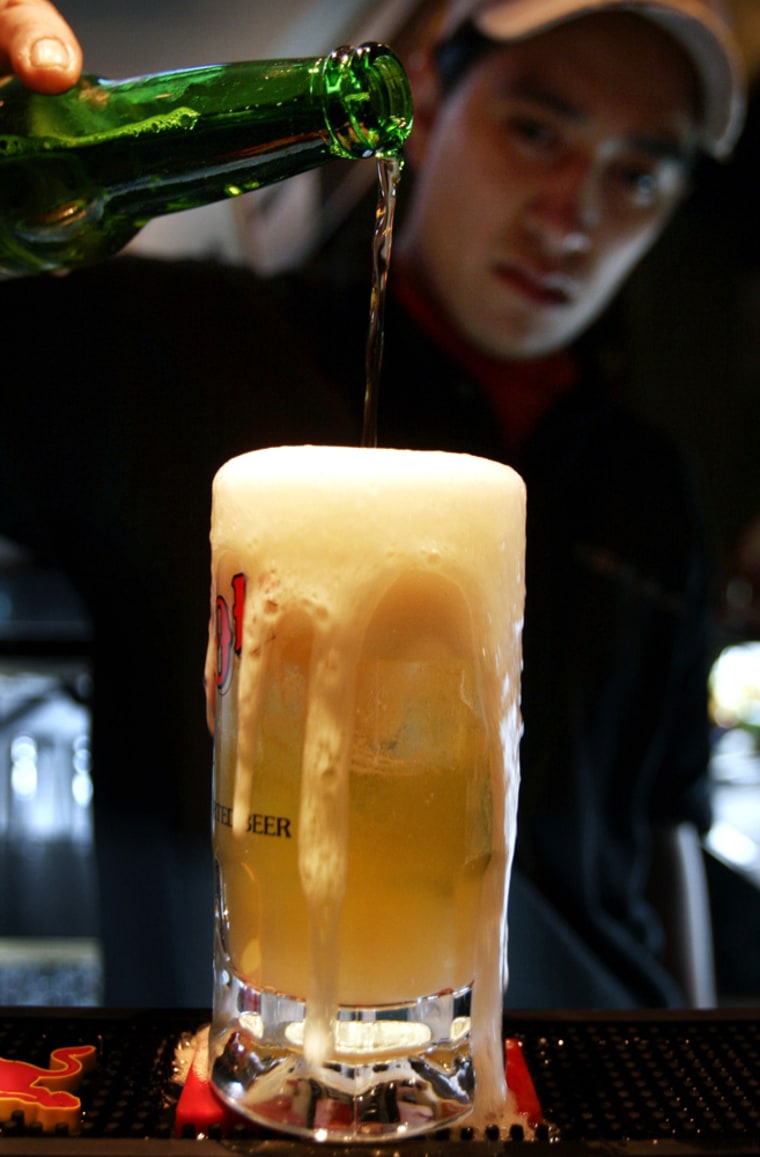Now that Americans have become accustomed to sticking lime wedges in their beers, Mexican companies are hoping they will start reaching for cold ones with a spicy kick.
Brewers, distributors and a company selling a pre-made mix are trying to cash in on the michelada — beer served with lime juice, assorted sweet-and-sour spices, chile pepper, ice and a salted rim — which has been a best seller south of the border for decades.
“The michelada isn’t new for Mexico, but in the United States it’s something special, something they only began to try recently and they like,” said Santiago Clariond, owner of Compania Alimenticia del Norte SA, which makes MicheMix.
“More people are getting to know the michelada every day,” he said.
The trend has gained steam as American tourists tasted the drink on trips to Mexico, then looked for something similar back home. Visitors to Mexican travel Internet bulletin boards have referred to micheladas as “beer lemonade.”
Clariond’s company began selling the mix in Mexico in 1999 and now exports it to the United States, Costa Rica and Guatemala.
Trying to break in
Tufic Salem, an analyst who tracks the beverage market for Credit Suisse First Boston in Mexico City, said micheladas have yet to catch on throughout the United States. Still, some companies are hoping they can help it become more popular.
Chicago-based Barton Beers Ltd. — which imports Mexican-made Grupo Modelo brands including Corona, Negra Modelo and Pacifico in 25 U.S. states — has launched michelada promotions with U.S. chains, including Marriott International Inc. hotels and El Torito Mexican restaurant chain.
“Like enjoying a lime with a Corona, we let the consumer determine what they prefer,” said Bill Ligas, a Barton spokesman. “However, we do see this as a unique opportunity to expand the use of beer as an alternative beverage to a wider audience.”
Salem agreed, saying: “This will certainly help Mexican beer companies. If you are going to make micheladas, you are going to use Mexican brands and that’s good for their sales.”
Restaurants and beer distributors stand to profit, too, said Tad Wilkes, who wrote an article about micheladas for Salud Y Buen Provecho, a supplement of Nightclub & Bar Magazine.
“More than ever, you’re seeing chain restaurants and others that provide beverage menus full of signature drinks,” said Wilkes, associate editor of Oxford Publishing, in Oxford, Miss. “It could be an opportunity for beers to tap into that, putting a michelada next to an apple martini.”
Many in Mexico say they won’t drink beer any other way.
“It gives it more flavor,” said Jose Alvear, a 33-year-old doctor who was sipping a michelada over lunch at a seafood restaurant in a fashionable corner of Mexico City’s Roma neighborhood. “It’s regular beer, but with more personality.”
Apocryphal origins
No one knows for sure where the michelada (mee-cha-LAH-dah) was invented, though bar owners all over Mexico claim they devised the recipe.
What goes in a michelada also depends on who you talk to. All include lime juice and salt, but recipes may call for adding Worcestershire sauce, liquid seasoning and soy sauce. Others include black pepper.
Using bottled hot sauce instead of chile pepper is becoming more common, though some prefer to leave out the spicy stuff altogether.
Even the meaning of its name is subject to debate. But most agree it comes from “mi chela helada,” Mexican slang for “My Cold Beer.”
Telling a story
A legend circulating on the Internet and picked up by some Mexican newspapers traces the michelada’s roots to a general named Augusto Michel, who hailed from San Luis Potosi state. But that was concocted by Clariond.
“I thought a story would add mystique to our product,” he said by telephone from company headquarters in the northern city of Monterrey.
Sold in 8.38-ounce plastic bottles, usually in the grocery store’s beer aisle, “MicheMix” features salt, lime juice and spices. The “picante” variety is spicy, while a basic mixture offers simply salt and lime.
Clariond acknowledged he is selling a mix made from items readily available in any home or restaurant, but said his product spares beer drinkers and bartenders the mess-making headaches of slicing limes and rummaging through the spice rack.
Consumer demand: Hecho en Mexico
He refused to discuss sales figures for strategic reasons, but said U.S. customers buy only about 4 percent of the mix his company sells annually. Sales in Central America are about half that much.
However, the American market should account for at least 25 percent of sales by 2007, he said.
Mexican brands have conquered the U.S. beer market before: Corona overtook Heineken and has been the United States’ top-selling import since 1997.
“If it’s a Mexican tradition, the consumer is going to demand it be made in Mexico,” Clariond said. “Customers have to see it as a plus that the product is produced here.”
